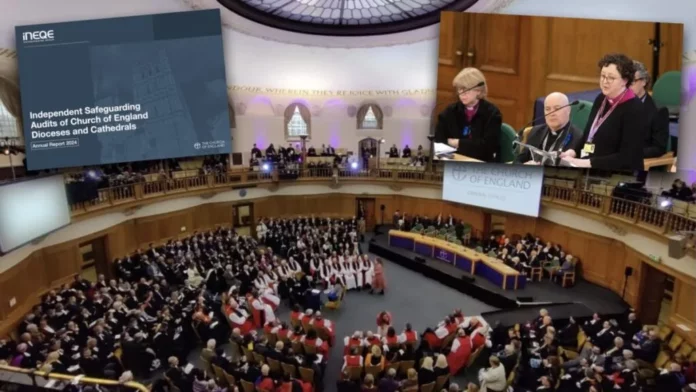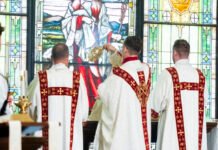Unless you have been living under a rock, you will be aware that safeguarding has been a deeply contentious issue in the Church of England for several years, and has come to a head over the last few months and weeks. Justin Welby resigned as Archbishop of Canterbury because of his failure to take action in relation to the past abuse of John Smyth, and Stephen Cottrell continues to face criticism in relation to his handling of David Tudor, who was banned from ministry because of past abuse.
This has created an atmosphere of intense pressure and scrutiny for any discussion about safeguarding, with different parties making strong and often conflicting demands, and that in turn has created a challenging context for fruitful discussion about the way forward for the Church. Nevertheless, much work has been done, and this week in Synod we have had several major discussions about safeguarding leading to key decisions—though I believe the main one has been badly misreported in the press and on social media.
On Monday afternoon, we had a debate about the response to the Makin report, which had documented the abuse of John Smyth mostly in the 1980s, and the failure of church leaders to deal with and prevent it. The complexity around Makin was that it was commissioned (by the Archbishops’ Council) five years ago, and should have report after nine months. I think a major failure of us on the Council was not to ask more questions about progress—and the final report, whilst leading to action, also contained errors of fact. In the debate, we heard testimony from Smyth victims, read by Julie Conalty, the deputy lead bishop for safeguarding, and in this and other debates we also heard from abuse survivors who are members of Synod. There was little to decide, and the debate finished early.
The main debate, though, run from Tuesday mid-morning to later in the afternoon; I estimated that we spent around four and three-quarters hours in the debate in total. The specific issue around independence itself has a complex background:
a. The IICSA report in 2020 raised the need for independence of scrutiny of safeguarding.
b. The Archbishops’ Council set up an interim ‘Independent Safeguarding Board’ in 2020, but the Wilkinson report on this noted its establishment was rushed and ill-thought-through, primarily because of pressure from Justin Welby.
c. The termination of the interim ISB because it was failure to deliver what was asked because very contentious at Synod in July 2023—not least because both Justin and Stephen delayed its termination out of a concern for the optics, which meant that it ran into Synod instead of being terminated earlier with a chance to put better plans in place.
d. Following this, the archbishops (through the Archbishops’ Council) commissioned Alexis Jay to report specifically on the options for independence of safeguarding in the Church of England. However, the brief as reported to the AC was for Jay to look at the options for independence, but when the report came out and was debated in February 2024, Jay was adamant that she had only considered the options for fully independent operation and scrutiny of safeguarding, and not the whole range of options.
This all meant that a tension was already created between some survivors and their advocates who expected full independence of operation and scrutiny, in line with Jay, and others, including other survivors and independent safeguarding experts, who believed that independent operation of safeguarding was unwise and unworkable—whilst independent scrutiny was essential. This tension was reflected in the lobbying beforehand and the response after the debate and decision.
The debate itself felt very different from previous discussion. There was a good deal of space, listening, and respect, and the voices of survivors, with their different views, were heard well. It did feel like we were in a much better place to explore the issues carefully and respectfully. John Bavington, who is a vicar in Bradford and a member of Synod, offered this excellent summary of the debate on Facebook, and I quote it with permission:
1. The people on General Synod are not stupid or evil or cowardly or self-interested or any of the other perjorative things which will likely be said about us. We met yesterday to discuss how to ensure that church is a safe community to be part of. The background is a series of scandals and subsequent reports and recommendations as to how to move forward. There is unanimous grief and repentance over the failings of the institution in the past. The voices of survivors and victims were heard and contributed to the discussion.
2. In front of us were two main options, known as “model 3” and “model 4”. To summarise them briefly:
Model 3 would mean that the Church of England continue to employ safeguarding staff in dioceses, cathedrals, and the national team, but would create a separate, totally independent organisation to have oversight of church safeguarding. Perhaps a good analogy would be the way that Ofsted oversees education.
Model 4 would mean that a new, totally independent organisation would be set up to employ all safeguarding professionals in the Church of England. This would be in addition to the new totally independent organisation which would be set up to provide oversight as in model 3.
3. The bishop with responsibility for safeguarding is Joanne Grenfell, an extremely capable person, who introduced the motion which would have committed us to model 4.
4. There were several proposed amendments and each was debated carefully and thoughtfully. For example there was an amendment proposed which would change the language of the motion from “greater independence” in safeguarding to “total independence”. While this sort of totalising language is attractive at one level, in the end it is unhelpful. For one thing, it is philosophically undesirable to describe safeguarding as something other people do, something independent of us, when all our language should be about how safeguarding is something we all do, something we are all responsible for. Secondly, it is utterly impossible to have totally independent safeguarding. The work begins in the parish, where our brilliant safeguarding officers are volunteers and members of our church, and how could they be “totally independent”?
5. One amendment proposed committing ourselves to model 3 (instead of model 4) and this gave us the opportunity to debate the pros and cons of both models. As far as I could see, the main reasons for choosing model 4 were (a) this was the model the majority of survivors of church abuse wanted us to choose; and (b) It would make a statement to the world (and the media) that we were holding nothing back in our desire to be transparent and accountable and humble. However, I was aware that the survivors and victims were not unanimous in their views, and I was very concerned that we should choose the best, safest option, not just the one which we were under pressure to choose because of the way it would look to others.
6. There seemed to me to be a number of good reasons for us to choose model 3 instead of model 4.
(a) No-one else anywhere has ever tried anything like model 4. It is untested, unknown, and unwieldy. The Bishop of Blackburn described it as “safeguarding done to us, rather than safeguarding done by us.” as such, I fear that it might in fact be unsafe.
(b) The vast majority of safeguarding professionals in the church recommended model 3. This was not self-interest (as someone unkindly suggested in a speech). Rather, it was the considered position of hard-working, experienced, committed professionals who actually manage the current system. And the current system is a million miles from what was (or wasn’t) in place when the scandals mentioned earlier took place.
(c) Legal advice from VWV solicitors warned that church charities (Diocesan Boards of Finance, Cathedral Chapters, etc) might find it extremely difficult to show that they they were meeting legal obligations as charities if we adopted model 4.
(d) This was reinforced by a letter from the Charity Commission reminding us all that charity trustees must consider safeguarding an essential part of their responsibility—not something which can be delegated to others.
(e) An opinion from Jim Gamble of the INEQE safeguarding audit group (who have been auditing church safeguarding for a year and a half), recommended model 3 rather than model 4.
(f) there are currently 85 charities in the C of E which employ safeguarding professionals (dioceses, cathedrals, nation church), and the task of transferring their employment, etc, to a new organisation is extremely complex with matters such as TUPE, variable terms of service, etc, to be considered. The new national organisation would have to create a new culture and identity, structures of management, etc, which would be complex and possibly opaque and introducing new, as yet unknown conflicts of interest. I am not sure it can be done well. I’m not convinced it would give us a safer outcome than we currently have.
7. The bishop of Blackburn proposed an amendment which gave us “model 3.5”. This was a good solution in my opinion. It involved adopting model 3, but not ruling out model 4 in the future. This would commit us to begin to do the due diligence on whether model 4 was doable and how it would work, whilst getting on with setting up the independent oversight which both models envisaged. We aren’t ready for model 4. We might never be ready for it, because it might not be the right model, but we won’t really know without a lot more dispassionate research and planning.
Summary: I think we have ended in the right place. So do the majority of Synod members, who voted for model 3.5. This includes the majority of the bishops. Before you launch into an online tirade, please respect the hours that have gone into the thoughtful consideration of these matters, the vast amount of reading we have all had to do, the careful prayer. May the Lord bless us all, and may the church be a safe place for all.
Not ONE person should come to harm through being part of the church community.
Following the vote, others also affirmed the wisdom of this decision. Justin Humphreys, leader of the independent safeguarding organization ThirtyOne:Eight, commented on Facebook (writing in a personal capacity):
Despite this not being perfect and with a real need for much further work, this was the best way forward from among the options presented. I have always advocated strongly for independent scrutiny and support. I gave evidence to this effect in my evidence to IICSA. We should not underestimate the difference that can be made through robust, clear and supportive oversight. Hopefully, we will begin to see the benefits of this before too long.
The other elements of independent operational safeguarding have always troubled me. It is unproven, risky and would have been disproportionately costly and time consuming to achieve. Let’s not also forget that the likely slowness of this would have slowed implementation of the scrutiny body, which has largely had unanimous support and is a proven improvement model.
Having led performance improvement and quality assurance functions in children’s social care and been the LA lead and liaison for regulatory inspections, I know this to be true. I have seen it and been involved from both sides of the fence.
And Mike Harrison, newly appointed as bishop of Exeter, offered a similar positive assessment. …
Read it all in Psephizo



